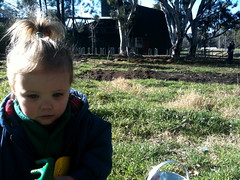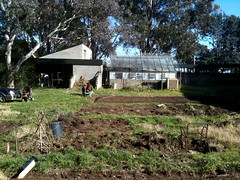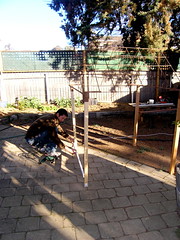Last week I visited my friend's community garden plot with my 2 year old daughter. My friend also has a 2 year old - in fact we met in our mums and bubs group!
 The plot is great and my friend is just getting started; mulching, composting and planting some winter broad beans and peas. Her son is also helping out and has his own little section of the plot. As we planted and raked, we talked about meeting others at the community garden and the space itself having lots of potential to set up small groups and workshops - especially a kids space!
The plot is great and my friend is just getting started; mulching, composting and planting some winter broad beans and peas. Her son is also helping out and has his own little section of the plot. As we planted and raked, we talked about meeting others at the community garden and the space itself having lots of potential to set up small groups and workshops - especially a kids space!
 We asked ourselves, what about a community garden playgroup to bring kids and parents together? There's such a thing elsewhere, like Macedon for example,
We asked ourselves, what about a community garden playgroup to bring kids and parents together? There's such a thing elsewhere, like Macedon for example,
Some of us have small children who now, after three years of going to ‘veggie club’, know each other and really look forward to gardening. My four year old is so keen if I mention I am going to do some gardening he gets very excited.Also, the Braybrook Community Gardens and Playgroup Victoria run a permaculture set up too, which looks awesome!
I did a bit of a search for such things around Canberra but so far, I can't find anything online. Is there such a thing? Does anyone know of a community garden space that playgroups may use or parent groups use as a meeting place? We'd love to hear about your set up if so!
There's been some great moves in setting up kitchen gardens as part of the curriculum in primary schools - Stephanie Alexander's program is very popular, for example. But what of younger kids and their parents?
Wouldn't it be great to hook in to both a parents group AND a shared gardening experience?















